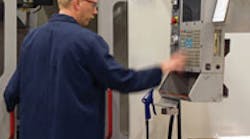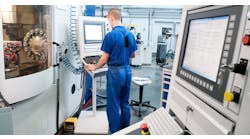By Mark Vidaic
A job shop with a standard capability in CNC machining can produce precision ceramic parts if it chooses the materials properly and approaches the process carefully.
Many shops struggle to offset the recent declines in revenue that have resulted from the weakened manufacturing sector, domestically and globally. While bureaucrats and bankers play with small-business credit, the average job shop may need to look inside to find ways to grow or restructure its capabilities, with minimal investment.
One way to do this is to expand the range of materials a shop can machine effectively. As an engineering material, ceramics pose different challenges for production methods, compared to a plastic or metal. Staying ahead of the knowledge curve can put a shop into position to benefit from a growing niche technology and market.
Ceramics are little understood in the high-tech world. Most application engineers do not think of ceramics as a stable material for manufacturing components. But, ceramics have found their way into some of the toughest applications and environments in the technical space. From aerospace to wear-resistant pump drives and rotors, to solar applications and even in the depths of the earth as components in down-hole oil and gas exploration, ceramics are becoming the material of choice when properties such as high temperature, dimensional stability, chemical/corrosion resistance, and electrical insulation are required. Many of your existing customers may already have a need for ceramic components, and your relationships may already be a foot in the door to a new opportunity.
The label “ceramics” covers a broad range of materials. There are many compositions for different applications. With cost-containment as a driver, the average shop needs only to learn some of the basics to start machining the “machinable” class of ceramic material — like Macor®, alumina silicate, boron nitride and other glass mica composites make up the majority of this class.
For the low- to medium-volume precision work, Macor® is a material that even a modestly equipped shop can machine into precision ceramic parts. Macor® is a Corning Inc. material. Corning is well know for its glass products and Macor® is a hybrid machinable glass-ceramic that can be fabricated into intricate shapes with tolerances on the order of 0.0002 in., with ordinary carbide tooling. For Ceramic Products Inc. Macor® and other types of machinable ceramics are a long-term solution, but also a bridge material for prototypes that eventually may get fabricated out of “tougher” fired ceramics. Macor®’s advantage is that it does not need to be machined in a “green” state and then fired. Fired ceramics typically need additional machining with diamond grit-bonded tooling to achieve the tighter tolerances via grinding instead of cutting.
Choosing the right tooling is likely to be the most complicated part of the learning process. Talk to your current suppliers, as they will have some of the best insight for you. For most machinable ceramics, solid carbide tooling is your best bet. Two flute end mills may cut more freely than 4 and 6 flute. There are some softer ceramics that are bisque or partially fired and not fully dense, and although they machine freely, these materials are very abrasive and will wear on the tool’s edge even faster than the denser machinable glass ceramics, such as Macor®.
For these materials, use diamond-plated burrs for milling and drilling. These tools will be a little more costly, but they will last surprisingly long because they will not wear like carbide. All diamond tooling will require the use of coolant to keep the tool free of mud/powder, in order to keep it cutting. It’s always helpful to wet machine ceramics to keep the workpiece and tool cool, regardless of whether it’s a solid-carbide tool or diamond-plated tool. This will extend tool life as well as introduce less stress into the material.
Ceramic materials are used in some of the most demanding applications and environments, from aerospace to wear-resistant pump drives and rotors, to solar applications and even in down-hole oil and gas exploration. They are valued for their high-temperature properties, dimensional stability, chemical/corrosion resistance, and electrical insulation.
Keep in mind that with wet or dry machining you are making either dust or mud, not chips. Some ceramics like boron nitride must be dry-machined, because they are porous ceramics and often used in applications where machining oils would be detrimental to the end use applications.
The resistance to machining ceramics has a lot to do with a reluctance to subject machine tools to such an abrasive material. However, if you were to dedicate a CNC retrofit knee mill/bed mill, or an older machine tool, the benefits will outweigh the machine wear. Remember, if you are at the point where you are wearing your machines you should be bringing in enough business to warrant dedicated equipment and setups.
If you have an old CNC sitting in the corner of the shop, it may be more advantageous to use it for these types of R&D projects than letting some auctioneer take it for next to nothing. Also, ceramics are not generally made into large components, because the material generally is not intended for use as the main component structure. They are usually used in an insulator application targeting a specific area of the end assembly. The point is that ceramic components are generally small and do not require large, expensive machines. Because ceramics are difficult to machine the average component may be a 2-axis or 3-axis job, at most. But even though they are not complicated, it’s possible to achieve a higher profit margin, because there are few shops willing to expand their portfolio to include ceramic materials.
Wet machining or drilling is preferred for ceramic materials, in order to keep the workpiece and tool cool (to extend service life) and to reduce the level of stress on the material.
Machining procedures for ceramics will pose an initial challenge, too, because they are so unfamiliar. Ceramics of all types are fragile under tensile forces, but exhibit great strength under compressive forces. This needs to be taken into account when deciding how to approach the workpiece. Ceramics such as Macor® will chip-out when milling if you exit the workpiece. The tool should remain in the cut as much as possible, and climb cutting is preferred to reduce chipping.
In many cases you cannot avoid exiting the workpiece, but if you leave excess material on the OD or profile of the workpiece you can clean up any defects as a final step, and make chip free parts. Sub-plates are a must for any through features, and they are a good way to incorporate workpiece holding. Because ceramics aren’t magnetic you can’t use magnetic chucks to hold the workpiece. Fencing the ceramic on a magnetic chuck with metal stock or waxing/taping to a sub-plate is a good alternative.
Most of the tricks you’ll need to learn about machining ceramics will be discovered on your own. There are resources available to you, though, including the companies like Ceramic Products Inc. that supply — and have experience at machining — many of the materials discussed here.
Mark Vidaic is the operations manager with Ceramic Products Inc., which machines advanced ceramics and technical plastics. Contact him at [email protected], or visit www.ceramicproductsinc.com
| Guide to ceramic materials Macor® — This machinable glass ceramic is made exclusively by Corning Inc., and has found many uses in aerospace, medical and semi-conductor applications. Macor® machinable glass ceramic can reduce costs where lower-volume quantities are needed and high-priced tooling charges are not an option. Macor® has a continuous-use temperature of 800°C and a peak temperature of 1,000°C. It’s coefficient of thermal expansion matches most metals and sealing glasses. Macor® is non-wetting, exhibits zero porosity, and unlike ductile materials, won’t deform. It’s an excellent insulator at high voltages, various frequencies and high temperatures, and won’t “outgas” in vacuum environments. Alumina — Alumina has good mechanical and electrical properties leading to a wide range of applications. Alumina can be produced in a range of purities with additives designed to enhance properties. It can be formed using a wide variety of ceramic processing methods and can be machined or formed to produce a wide variety of sizes and shapes. In addition, it can be readily joined to metals or other ceramics using metalizing and brazing techniques. Aluminum nitride — Aluminum nitride exhibits lower thermal expansion than alumina that closely matches the expansion of silicon wafers and it can be metalized, making it an ideal material for semi-conductor applications. Alumina silicate (Lava) — Alumina silicate or Lava is a machinable ceramic material. It has a high use temperature, and excellent thermal / electrical insulating properties. Boron nitride — Boron nitride can be machined using standard carbide drills. BN exhibits a high electrical resistance, low dielectric constant and loss tangent, low thermal expansion, chemical inertness and good thermal shock resistance. With these properties BN lends itself a useful material for vacuum components, various electrical components and nuclear applications. Glass (Pyrex®, Vycor® and similar materials) — Various glasses are used in many applications where optical high thermal shock resistance and insulating properties are required. Graphite — Graphite has excellent thermal shock and chemical resistance making it an ideal material for molds, furnace boats, plating anodes and brazing fixtures. Mullite — Mullite is an excellent structural material due to its high temperature stability, strength and creep resistance. It has a low dielectric constant and high electrical insulation capabilities. Typical applications include Kiln Furniture, furnace center tube, heat exchange parts, heat insulation parts and rollers. Mycalex®— With several grades to choose from, varying in strength and temperature performance, Mycalex® is an excellent machinable ceramic insulator material that can be fabricated into complex parts. Quartz — With its superior thermal, chemical and optical properties, quartz often is used in the lighting and semi-conductor fields. Silicon carbide — Silicon carbide is known for its high hardness and abrasion resistance. Common applications include: pump seals, valve components and wear-intensive parts. Steatite — The cost of Steatite is relatively low when compared with other ceramic materials. It’s useful in applications where insulating and temperature resistance are a concern. Zirconia — Stabilized zirconia offers chemical and corrosion resistance to temperatures well above the melting point of alumina. Zirconia ceramics have the ability to absorb great amounts of stress relative to other ceramic materials. It exhibits the highest mechanical strength and toughness at room temperature. |






